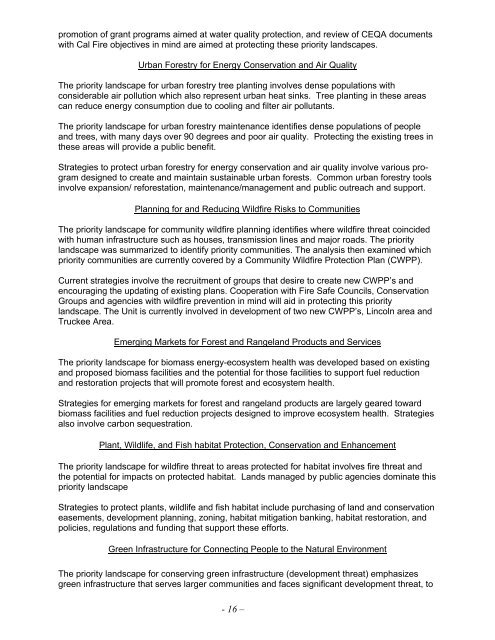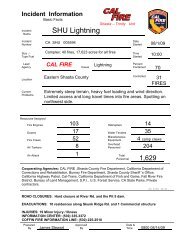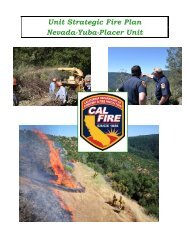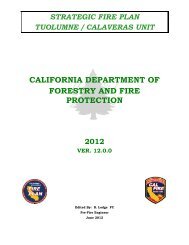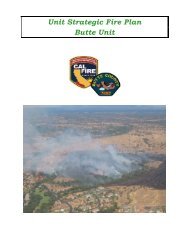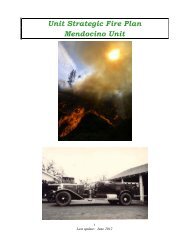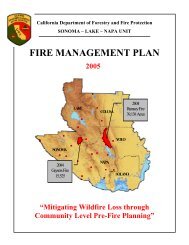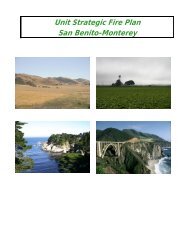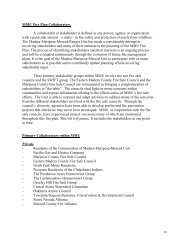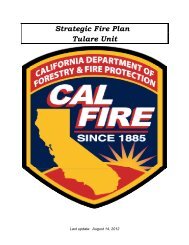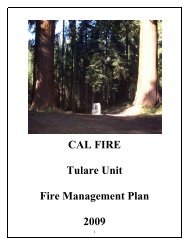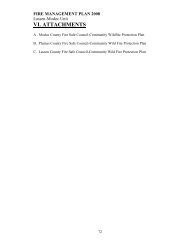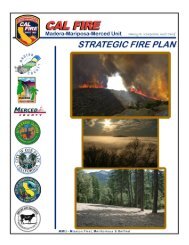Nevada-Yuba-Placer Strategic Fire Plan 2011 - Board of Forestry ...
Nevada-Yuba-Placer Strategic Fire Plan 2011 - Board of Forestry ...
Nevada-Yuba-Placer Strategic Fire Plan 2011 - Board of Forestry ...
Create successful ePaper yourself
Turn your PDF publications into a flip-book with our unique Google optimized e-Paper software.
promotion <strong>of</strong> grant programs aimed at water quality protection, and review <strong>of</strong> CEQA documents<br />
with Cal <strong>Fire</strong> objectives in mind are aimed at protecting these priority landscapes.<br />
Urban <strong>Forestry</strong> for Energy Conservation and Air Quality<br />
The priority landscape for urban forestry tree planting involves dense populations with<br />
considerable air pollution which also represent urban heat sinks. Tree planting in these areas<br />
can reduce energy consumption due to cooling and filter air pollutants.<br />
The priority landscape for urban forestry maintenance identifies dense populations <strong>of</strong> people<br />
and trees, with many days over 90 degrees and poor air quality. Protecting the existing trees in<br />
these areas will provide a public benefit.<br />
Strategies to protect urban forestry for energy conservation and air quality involve various program<br />
designed to create and maintain sustainable urban forests. Common urban forestry tools<br />
involve expansion/ reforestation, maintenance/management and public outreach and support.<br />
<strong>Plan</strong>ning for and Reducing Wildfire Risks to Communities<br />
The priority landscape for community wildfire planning identifies where wildfire threat coincided<br />
with human infrastructure such as houses, transmission lines and major roads. The priority<br />
landscape was summarized to identify priority communities. The analysis then examined which<br />
priority communities are currently covered by a Community Wildfire Protection <strong>Plan</strong> (CWPP).<br />
Current strategies involve the recruitment <strong>of</strong> groups that desire to create new CWPP’s and<br />
encouraging the updating <strong>of</strong> existing plans. Cooperation with <strong>Fire</strong> Safe Councils, Conservation<br />
Groups and agencies with wildfire prevention in mind will aid in protecting this priority<br />
landscape. The Unit is currently involved in development <strong>of</strong> two new CWPP’s, Lincoln area and<br />
Truckee Area.<br />
Emerging Markets for Forest and Rangeland Products and Services<br />
The priority landscape for biomass energy-ecosystem health was developed based on existing<br />
and proposed biomass facilities and the potential for those facilities to support fuel reduction<br />
and restoration projects that will promote forest and ecosystem health.<br />
Strategies for emerging markets for forest and rangeland products are largely geared toward<br />
biomass facilities and fuel reduction projects designed to improve ecosystem health. Strategies<br />
also involve carbon sequestration.<br />
<strong>Plan</strong>t, Wildlife, and Fish habitat Protection, Conservation and Enhancement<br />
The priority landscape for wildfire threat to areas protected for habitat involves fire threat and<br />
the potential for impacts on protected habitat. Lands managed by public agencies dominate this<br />
priority landscape<br />
Strategies to protect plants, wildlife and fish habitat include purchasing <strong>of</strong> land and conservation<br />
easements, development planning, zoning, habitat mitigation banking, habitat restoration, and<br />
policies, regulations and funding that support these efforts.<br />
Green Infrastructure for Connecting People to the Natural Environment<br />
The priority landscape for conserving green infrastructure (development threat) emphasizes<br />
green infrastructure that serves larger communities and faces significant development threat, to<br />
- 16 –


